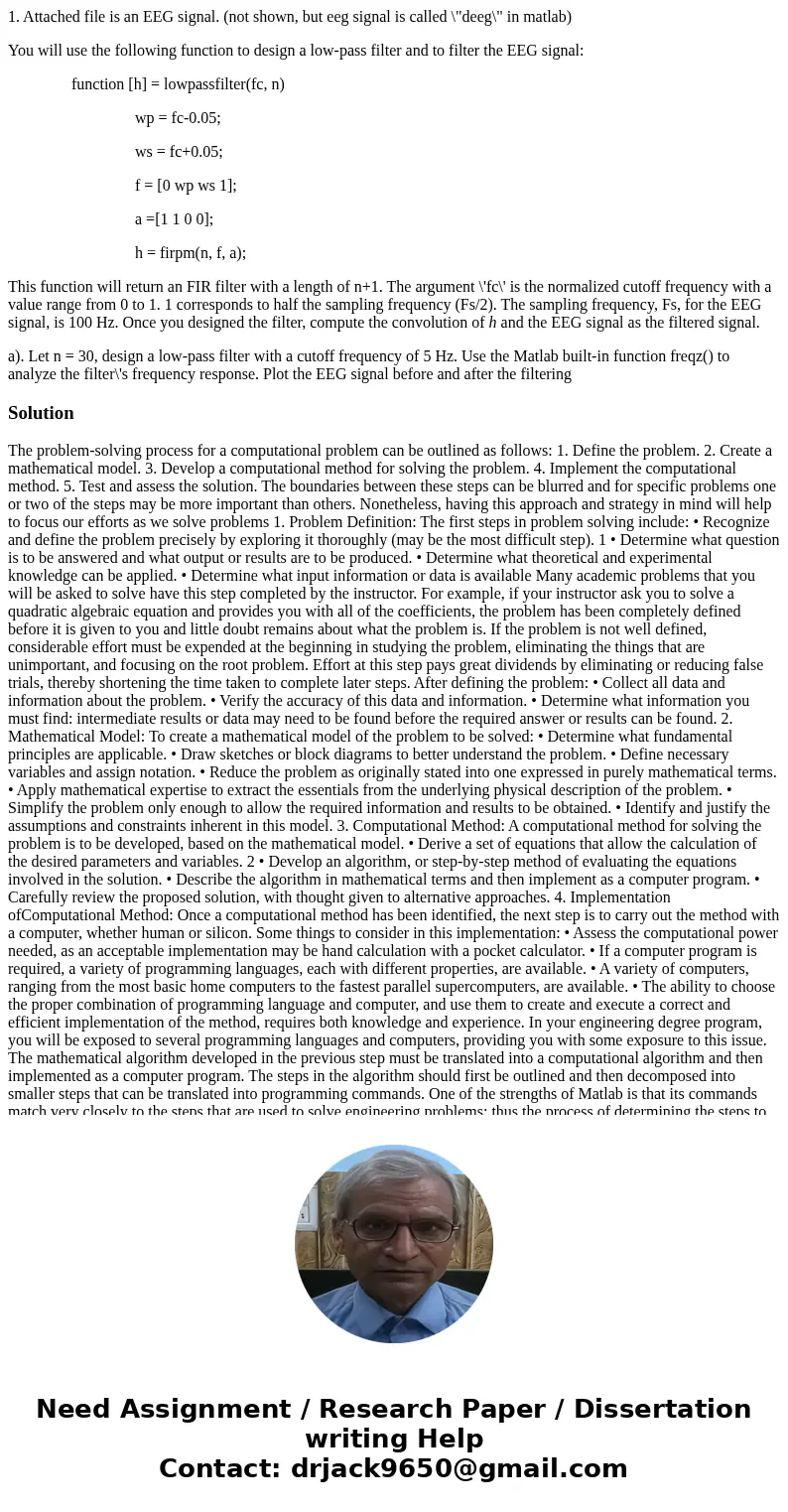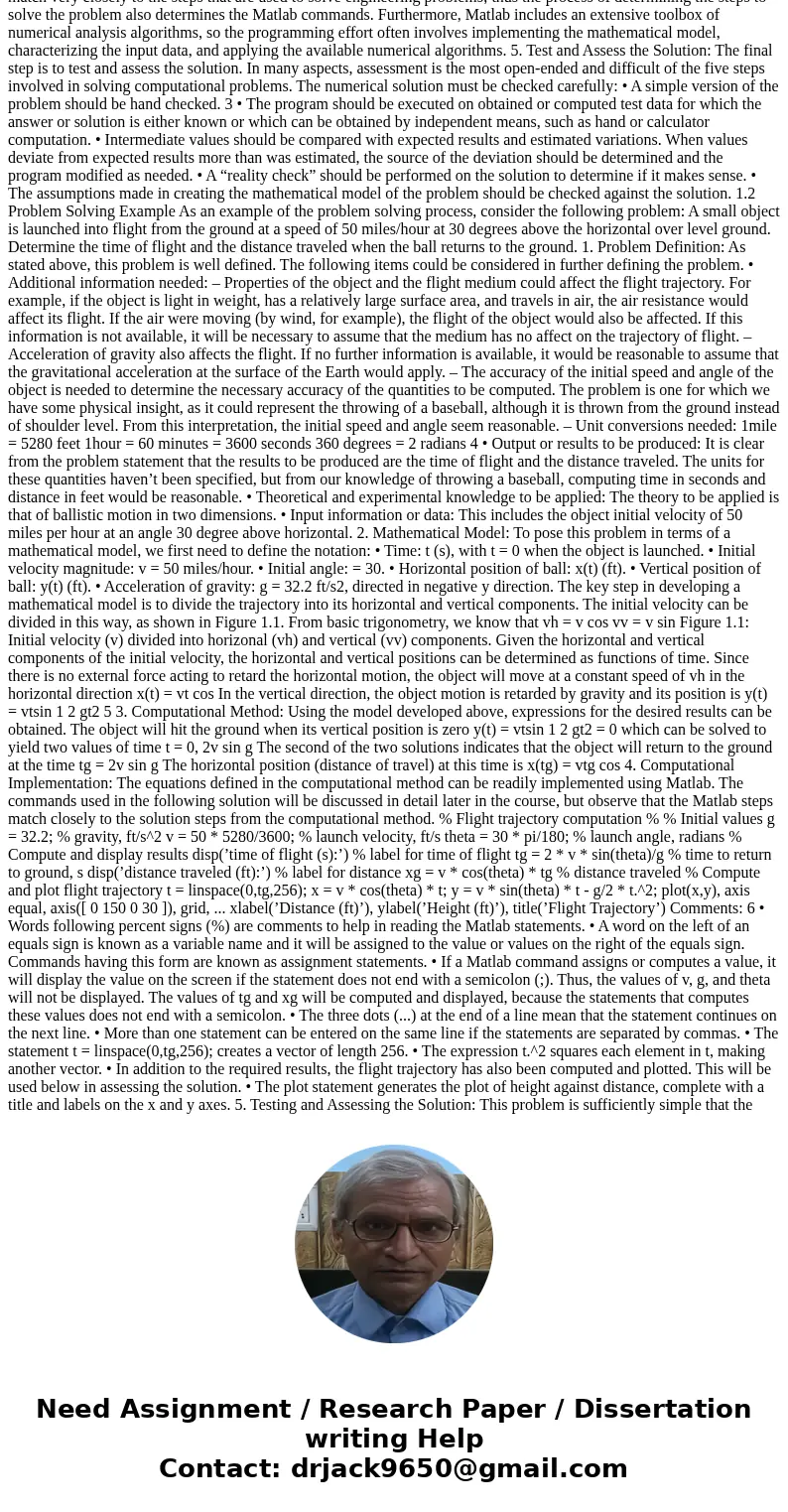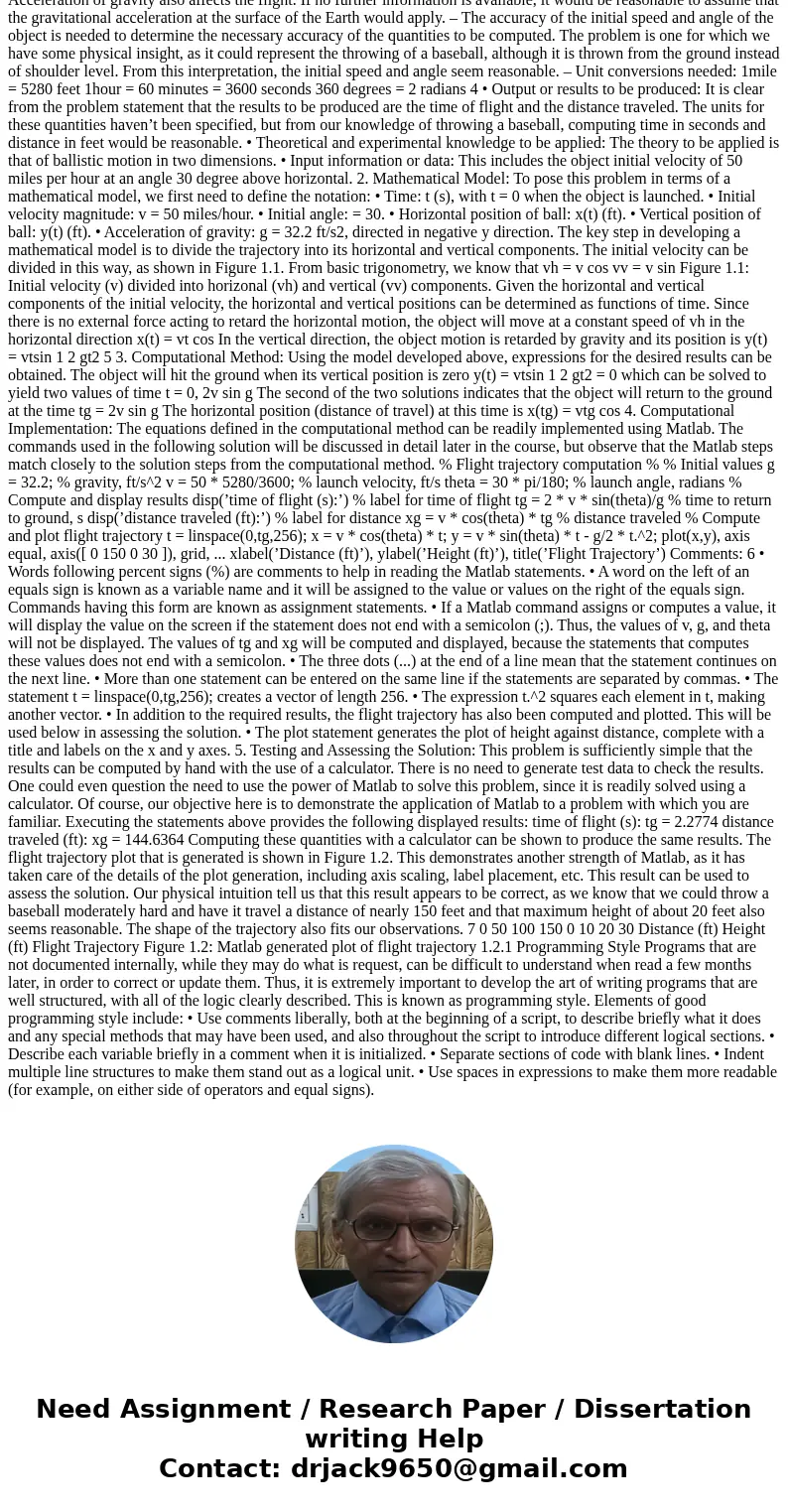1 Attached file is an EEG signal not shown but eeg signal is
1. Attached file is an EEG signal. (not shown, but eeg signal is called \"deeg\" in matlab)
You will use the following function to design a low-pass filter and to filter the EEG signal:
function [h] = lowpassfilter(fc, n)
wp = fc-0.05;
ws = fc+0.05;
f = [0 wp ws 1];
a =[1 1 0 0];
h = firpm(n, f, a);
This function will return an FIR filter with a length of n+1. The argument \'fc\' is the normalized cutoff frequency with a value range from 0 to 1. 1 corresponds to half the sampling frequency (Fs/2). The sampling frequency, Fs, for the EEG signal, is 100 Hz. Once you designed the filter, compute the convolution of h and the EEG signal as the filtered signal.
a). Let n = 30, design a low-pass filter with a cutoff frequency of 5 Hz. Use the Matlab built-in function freqz() to analyze the filter\'s frequency response. Plot the EEG signal before and after the filtering
Solution
The problem-solving process for a computational problem can be outlined as follows: 1. Define the problem. 2. Create a mathematical model. 3. Develop a computational method for solving the problem. 4. Implement the computational method. 5. Test and assess the solution. The boundaries between these steps can be blurred and for specific problems one or two of the steps may be more important than others. Nonetheless, having this approach and strategy in mind will help to focus our efforts as we solve problems 1. Problem Definition: The first steps in problem solving include: • Recognize and define the problem precisely by exploring it thoroughly (may be the most difficult step). 1 • Determine what question is to be answered and what output or results are to be produced. • Determine what theoretical and experimental knowledge can be applied. • Determine what input information or data is available Many academic problems that you will be asked to solve have this step completed by the instructor. For example, if your instructor ask you to solve a quadratic algebraic equation and provides you with all of the coefficients, the problem has been completely defined before it is given to you and little doubt remains about what the problem is. If the problem is not well defined, considerable effort must be expended at the beginning in studying the problem, eliminating the things that are unimportant, and focusing on the root problem. Effort at this step pays great dividends by eliminating or reducing false trials, thereby shortening the time taken to complete later steps. After defining the problem: • Collect all data and information about the problem. • Verify the accuracy of this data and information. • Determine what information you must find: intermediate results or data may need to be found before the required answer or results can be found. 2. Mathematical Model: To create a mathematical model of the problem to be solved: • Determine what fundamental principles are applicable. • Draw sketches or block diagrams to better understand the problem. • Define necessary variables and assign notation. • Reduce the problem as originally stated into one expressed in purely mathematical terms. • Apply mathematical expertise to extract the essentials from the underlying physical description of the problem. • Simplify the problem only enough to allow the required information and results to be obtained. • Identify and justify the assumptions and constraints inherent in this model. 3. Computational Method: A computational method for solving the problem is to be developed, based on the mathematical model. • Derive a set of equations that allow the calculation of the desired parameters and variables. 2 • Develop an algorithm, or step-by-step method of evaluating the equations involved in the solution. • Describe the algorithm in mathematical terms and then implement as a computer program. • Carefully review the proposed solution, with thought given to alternative approaches. 4. Implementation ofComputational Method: Once a computational method has been identified, the next step is to carry out the method with a computer, whether human or silicon. Some things to consider in this implementation: • Assess the computational power needed, as an acceptable implementation may be hand calculation with a pocket calculator. • If a computer program is required, a variety of programming languages, each with different properties, are available. • A variety of computers, ranging from the most basic home computers to the fastest parallel supercomputers, are available. • The ability to choose the proper combination of programming language and computer, and use them to create and execute a correct and efficient implementation of the method, requires both knowledge and experience. In your engineering degree program, you will be exposed to several programming languages and computers, providing you with some exposure to this issue. The mathematical algorithm developed in the previous step must be translated into a computational algorithm and then implemented as a computer program. The steps in the algorithm should first be outlined and then decomposed into smaller steps that can be translated into programming commands. One of the strengths of Matlab is that its commands match very closely to the steps that are used to solve engineering problems; thus the process of determining the steps to solve the problem also determines the Matlab commands. Furthermore, Matlab includes an extensive toolbox of numerical analysis algorithms, so the programming effort often involves implementing the mathematical model, characterizing the input data, and applying the available numerical algorithms. 5. Test and Assess the Solution: The final step is to test and assess the solution. In many aspects, assessment is the most open-ended and difficult of the five steps involved in solving computational problems. The numerical solution must be checked carefully: • A simple version of the problem should be hand checked. 3 • The program should be executed on obtained or computed test data for which the answer or solution is either known or which can be obtained by independent means, such as hand or calculator computation. • Intermediate values should be compared with expected results and estimated variations. When values deviate from expected results more than was estimated, the source of the deviation should be determined and the program modified as needed. • A “reality check” should be performed on the solution to determine if it makes sense. • The assumptions made in creating the mathematical model of the problem should be checked against the solution. 1.2 Problem Solving Example As an example of the problem solving process, consider the following problem: A small object is launched into flight from the ground at a speed of 50 miles/hour at 30 degrees above the horizontal over level ground. Determine the time of flight and the distance traveled when the ball returns to the ground. 1. Problem Definition: As stated above, this problem is well defined. The following items could be considered in further defining the problem. • Additional information needed: – Properties of the object and the flight medium could affect the flight trajectory. For example, if the object is light in weight, has a relatively large surface area, and travels in air, the air resistance would affect its flight. If the air were moving (by wind, for example), the flight of the object would also be affected. If this information is not available, it will be necessary to assume that the medium has no affect on the trajectory of flight. – Acceleration of gravity also affects the flight. If no further information is available, it would be reasonable to assume that the gravitational acceleration at the surface of the Earth would apply. – The accuracy of the initial speed and angle of the object is needed to determine the necessary accuracy of the quantities to be computed. The problem is one for which we have some physical insight, as it could represent the throwing of a baseball, although it is thrown from the ground instead of shoulder level. From this interpretation, the initial speed and angle seem reasonable. – Unit conversions needed: 1mile = 5280 feet 1hour = 60 minutes = 3600 seconds 360 degrees = 2 radians 4 • Output or results to be produced: It is clear from the problem statement that the results to be produced are the time of flight and the distance traveled. The units for these quantities haven’t been specified, but from our knowledge of throwing a baseball, computing time in seconds and distance in feet would be reasonable. • Theoretical and experimental knowledge to be applied: The theory to be applied is that of ballistic motion in two dimensions. • Input information or data: This includes the object initial velocity of 50 miles per hour at an angle 30 degree above horizontal. 2. Mathematical Model: To pose this problem in terms of a mathematical model, we first need to define the notation: • Time: t (s), with t = 0 when the object is launched. • Initial velocity magnitude: v = 50 miles/hour. • Initial angle: = 30. • Horizontal position of ball: x(t) (ft). • Vertical position of ball: y(t) (ft). • Acceleration of gravity: g = 32.2 ft/s2, directed in negative y direction. The key step in developing a mathematical model is to divide the trajectory into its horizontal and vertical components. The initial velocity can be divided in this way, as shown in Figure 1.1. From basic trigonometry, we know that vh = v cos vv = v sin Figure 1.1: Initial velocity (v) divided into horizonal (vh) and vertical (vv) components. Given the horizontal and vertical components of the initial velocity, the horizontal and vertical positions can be determined as functions of time. Since there is no external force acting to retard the horizontal motion, the object will move at a constant speed of vh in the horizontal direction x(t) = vt cos In the vertical direction, the object motion is retarded by gravity and its position is y(t) = vtsin 1 2 gt2 5 3. Computational Method: Using the model developed above, expressions for the desired results can be obtained. The object will hit the ground when its vertical position is zero y(t) = vtsin 1 2 gt2 = 0 which can be solved to yield two values of time t = 0, 2v sin g The second of the two solutions indicates that the object will return to the ground at the time tg = 2v sin g The horizontal position (distance of travel) at this time is x(tg) = vtg cos 4. Computational Implementation: The equations defined in the computational method can be readily implemented using Matlab. The commands used in the following solution will be discussed in detail later in the course, but observe that the Matlab steps match closely to the solution steps from the computational method. % Flight trajectory computation % % Initial values g = 32.2; % gravity, ft/s^2 v = 50 * 5280/3600; % launch velocity, ft/s theta = 30 * pi/180; % launch angle, radians % Compute and display results disp(’time of flight (s):’) % label for time of flight tg = 2 * v * sin(theta)/g % time to return to ground, s disp(’distance traveled (ft):’) % label for distance xg = v * cos(theta) * tg % distance traveled % Compute and plot flight trajectory t = linspace(0,tg,256); x = v * cos(theta) * t; y = v * sin(theta) * t - g/2 * t.^2; plot(x,y), axis equal, axis([ 0 150 0 30 ]), grid, ... xlabel(’Distance (ft)’), ylabel(’Height (ft)’), title(’Flight Trajectory’) Comments: 6 • Words following percent signs (%) are comments to help in reading the Matlab statements. • A word on the left of an equals sign is known as a variable name and it will be assigned to the value or values on the right of the equals sign. Commands having this form are known as assignment statements. • If a Matlab command assigns or computes a value, it will display the value on the screen if the statement does not end with a semicolon (;). Thus, the values of v, g, and theta will not be displayed. The values of tg and xg will be computed and displayed, because the statements that computes these values does not end with a semicolon. • The three dots (...) at the end of a line mean that the statement continues on the next line. • More than one statement can be entered on the same line if the statements are separated by commas. • The statement t = linspace(0,tg,256); creates a vector of length 256. • The expression t.^2 squares each element in t, making another vector. • In addition to the required results, the flight trajectory has also been computed and plotted. This will be used below in assessing the solution. • The plot statement generates the plot of height against distance, complete with a title and labels on the x and y axes. 5. Testing and Assessing the Solution: This problem is sufficiently simple that the results can be computed by hand with the use of a calculator. There is no need to generate test data to check the results. One could even question the need to use the power of Matlab to solve this problem, since it is readily solved using a calculator. Of course, our objective here is to demonstrate the application of Matlab to a problem with which you are familiar. Executing the statements above provides the following displayed results: time of flight (s): tg = 2.2774 distance traveled (ft): xg = 144.6364 Computing these quantities with a calculator can be shown to produce the same results. The flight trajectory plot that is generated is shown in Figure 1.2. This demonstrates another strength of Matlab, as it has taken care of the details of the plot generation, including axis scaling, label placement, etc. This result can be used to assess the solution. Our physical intuition tell us that this result appears to be correct, as we know that we could throw a baseball moderately hard and have it travel a distance of nearly 150 feet and that maximum height of about 20 feet also seems reasonable. The shape of the trajectory also fits our observations. 7 0 50 100 150 0 10 20 30 Distance (ft) Height (ft) Flight Trajectory Figure 1.2: Matlab generated plot of flight trajectory 1.2.1 Programming Style Programs that are not documented internally, while they may do what is request, can be difficult to understand when read a few months later, in order to correct or update them. Thus, it is extremely important to develop the art of writing programs that are well structured, with all of the logic clearly described. This is known as programming style. Elements of good programming style include: • Use comments liberally, both at the beginning of a script, to describe briefly what it does and any special methods that may have been used, and also throughout the script to introduce different logical sections. • Describe each variable briefly in a comment when it is initialized. • Separate sections of code with blank lines. • Indent multiple line structures to make them stand out as a logical unit. • Use spaces in expressions to make them more readable (for example, on either side of operators and equal signs).



 Homework Sourse
Homework Sourse